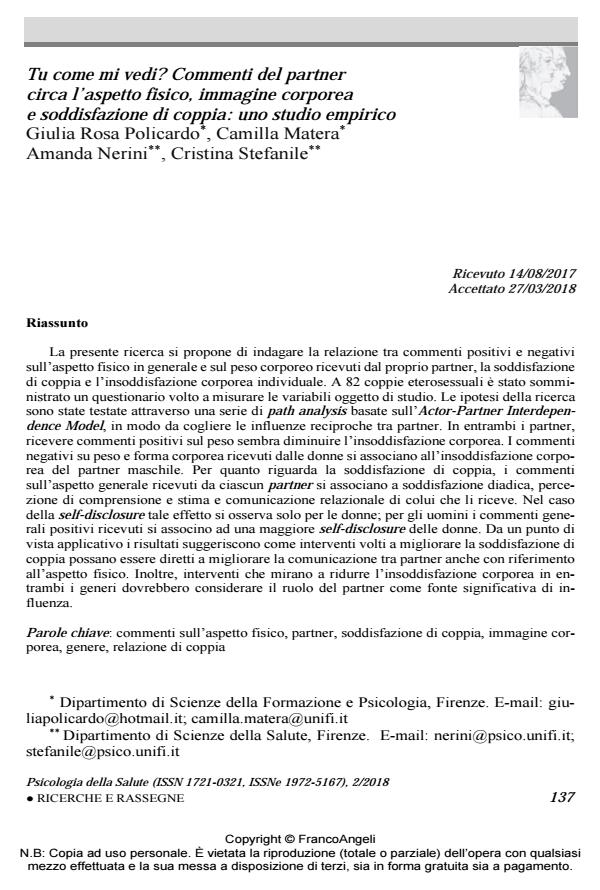How do you see me? Appearance commentary from partner, body image and couple satisfaction: an empirical study
Journal title PSICOLOGIA DELLA SALUTE
Author/s Giulia Rosa Policardo, Camilla Matera, Amanda Nerini, Cristina Stefanile
Publishing Year 2018 Issue 2018/2
Language Italian Pages 21 P. 137-157 File size 373 KB
DOI 10.3280/PDS2018-002011
DOI is like a bar code for intellectual property: to have more infomation
click here
Below, you can see the article first page
If you want to buy this article in PDF format, you can do it, following the instructions to buy download credits

FrancoAngeli is member of Publishers International Linking Association, Inc (PILA), a not-for-profit association which run the CrossRef service enabling links to and from online scholarly content.
The present research aims to investigate the relationship between positive and negative comments about general appearance and weight received by the partner, couple satisfaction and individual body dissatisfaction. 82 heterosexual couples were given a questionnaire designed to measure the examined variables. The research hypotheses were tested through a series of path analyses based on the Actor-Partner Interdependence Model, in order to capture reciprocal influences between partners. In both partners, to receive positive comments about weight is associated with lower body dissatisfaction. Negative comments about weight and shape received by women are associated with their male partner’s body dissatisfaction. With respect to couple satisfaction, comments about general appearance received by each partner are associated with dyadic satisfaction, perception of comprehension and esteem, and relational communication reported by the partner who receives them. For self-disclosure this effect is significant only among women; among men comments on general appearance are associated with higher self-disclosure reported by their female partner. From a practical point of view these results suggest that interventions aimed to enhance couple satisfaction could be directed to improve partner communication also with respect to appearance. Moreover, interventions designed to reduce body dissatisfaction in both genders should consider the role of the partner as a significant source of influence.
Keywords: Appearance commentary, partner, couple satisfaction, body image, gender, couple relationship
- The Power of Words: Appearance Comments from One’s Partner Can Affect Men’s Body Image and Women’s Couple Relationship Elena Fornaini, Camilla Matera, Amanda Nerini, Giulia Rosa Policardo, Cristian Di Gesto, in International Journal of Environmental Research and Public Health /2021 pp.9319
DOI: 10.3390/ijerph18179319 - Heterosexual Script in Italian Young Adults: Measurement Across Genders Agathe Scappini, Maria Anna Donati, Giulia Fioravanti, in Sexuality Research and Social Policy /2023 pp.1152
DOI: 10.1007/s13178-022-00786-9 - Not All That Glitters Is Gold: Attractive Partners Provide Joys and Sorrows Anna Cardelli, Camilla Matera, Giulia Rosa Policardo, Cristian Di Gesto, Amanda Nerini, in International Journal of Environmental Research and Public Health /2022 pp.13526
DOI: 10.3390/ijerph192013526 - Influenze socioculturali, immagine corporea e chirurgia estetica Cristian Di Gesto, (ISBN:979-12-215-0673-0)
Giulia Rosa Policardo, Camilla Matera, Amanda Nerini, Cristina Stefanile, Tu come mi vedi? Commenti del partner circa l’aspetto fisico, immagine corporea e soddisfazione di coppia: uno studio empirico in "PSICOLOGIA DELLA SALUTE" 2/2018, pp 137-157, DOI: 10.3280/PDS2018-002011